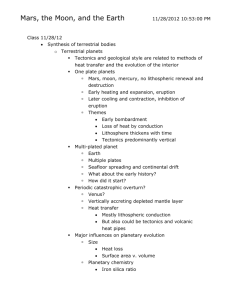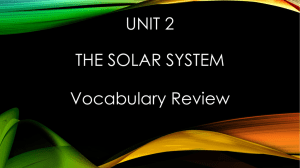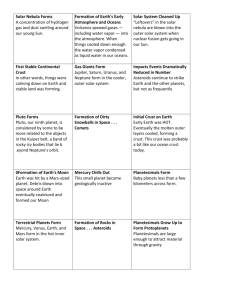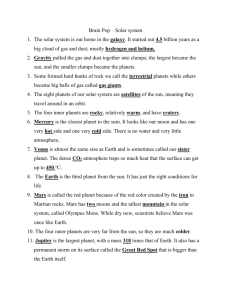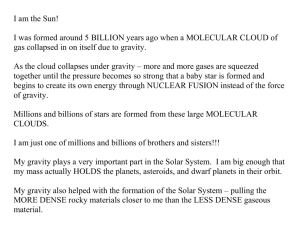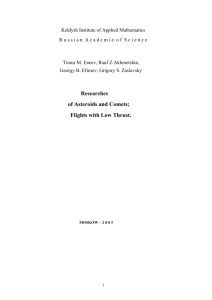Review Worksheet On Astronomy
advertisement
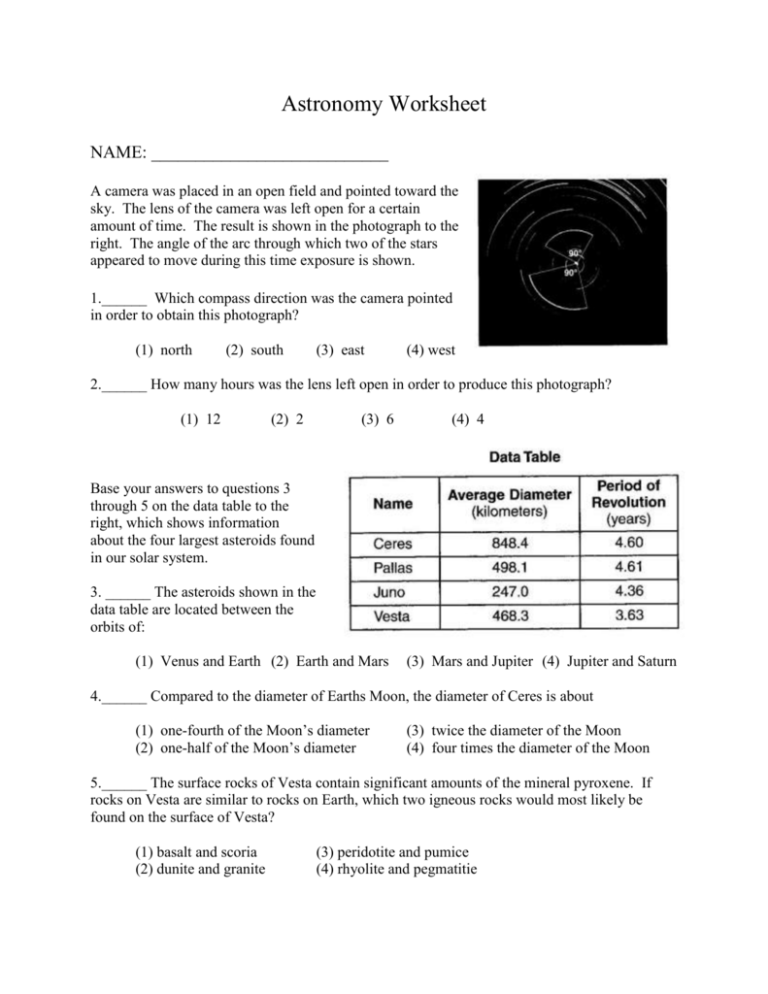
Astronomy Worksheet NAME: ___________________________ A camera was placed in an open field and pointed toward the sky. The lens of the camera was left open for a certain amount of time. The result is shown in the photograph to the right. The angle of the arc through which two of the stars appeared to move during this time exposure is shown. 1.______ Which compass direction was the camera pointed in order to obtain this photograph? (1) north (2) south (3) east (4) west 2.______ How many hours was the lens left open in order to produce this photograph? (1) 12 (2) 2 (3) 6 (4) 4 Base your answers to questions 3 through 5 on the data table to the right, which shows information about the four largest asteroids found in our solar system. 3. ______ The asteroids shown in the data table are located between the orbits of: (1) Venus and Earth (2) Earth and Mars (3) Mars and Jupiter (4) Jupiter and Saturn 4.______ Compared to the diameter of Earths Moon, the diameter of Ceres is about (1) one-fourth of the Moon’s diameter (2) one-half of the Moon’s diameter (3) twice the diameter of the Moon (4) four times the diameter of the Moon 5.______ The surface rocks of Vesta contain significant amounts of the mineral pyroxene. If rocks on Vesta are similar to rocks on Earth, which two igneous rocks would most likely be found on the surface of Vesta? (1) basalt and scoria (2) dunite and granite (3) peridotite and pumice (4) rhyolite and pegmatitie Base your answers to questions 6 through 8 on the diagram to the right, which represents a model of Earth’s orbit. Earth is closest to the Sun at one point in its orbit (perihelion) and farthest from the Sun at another point (aphelion). The Sun and point B represent the foci of this orbit. 6. Explain why Earth’s orbit is considered to be elliptical. 7. Describe the change that takes place in the gravitational attraction between Earth and the Sun as Earth moves from perihelion to aphelion and back to perihelion during one year. 8. Describe how the shape of Earth’s orbit would differ if the Sun and focus B were farther apart. Base your answers to questions 9 through 11 on the passage below and on your knowledge of stars and galaxies. Stars can be classified according to their properties, such as diameter, mass, luminosity and temperature. Some stars are so large that the orbits of the planets in our solar system would easily fit inside them. Stars are grouped together in galaxies covering vast distances. Galaxies contain from 100 billion to over 300 billion stars. Astronomers have discovered billions of galaxies in the universe. 9. Arrange the terms galaxy, star, and universe in order from largest to smallest. ____________________ ____________________ ____________________ Largest ----------------------------------------------------------------- Smallest 10.______ Which planet’s orbit around the Sun is most nearly circular? (1) Mercury (2) Neptune (3) Saturn (4) Venus The bar graph to the right shows one planetary characteristic, identified as X, plotted for the planets of our solar system. 11.______ Which characteristic of the planets in our solar system is represented by X? (1) mass (2) density (3) eccentricity of orbit (4) period of rotation Base your answers to questions 12 though 14 on the passage below. Is Earth Gaining Weight? Scientists believe that Earth may gain more than 100 tons of dust from space every day. The dust comes from thawing comets as they orbit the Sun and from pieces of asteroids that collided with other asteroids. Most asteroids orbit the Sun between Mars and Jupiter. Each dust particle dates back to the days when our solar system was created. So in a way, each tiny speck of dust holds clues to how our solar system formed. All the space dust provided by comets and asteroids in our solar system is drawn to the Sun by its gravitational force. However, space dust that passes within about 60 miles of Earth’s surface may be slowed enough by friction with Earth’s atmosphere to be pulled to the surface by Earth’s gravity. 12. State one reason why more space dust is attracted to the Sun than to Earth. 13. In which temperature zone of Earth’s atmosphere is space dust first slowed enough by friction to be pulled to Earth’s surface? 14. Approximately how many million kilometers from the Sun are most asteroids located? The diagram to the right shows a portion of the solar system. 15.______ What is the average distance, in millions of kilometers, from the Sun to the asteroid belt? (1) 129 (2) 189 (3) 503 (4) 857 Base your answers to questions 16 through 18 on the diagram to the right which shows the heliocentric model of a part of our solar system. The planets closest to the Sun are shown. Point B is a location on Earth’s equator. 16. State the name of planet A. 17. Explain why location B experiences both day and night in a 24-hour period. 18. Identify one feature of the geocentric model of our solar system that differs from the heliocentric model shown. 19.______ Which planet has the least distance between the two foci of its elliptical orbit? (1) Venus (2) Earth (3) Mars The data table to the right shows the average distance from the Sun, the average surface temperature, and the average orbital velocity for each planet in our solar system. 20. State the relationship between the average distance from the sun and the average surface temperature of the Jovian planets. (4) Jupiter 21. On the graph to the right, draw a line to indicate the general relationship between a planet’s average distance from the Sun and its average orbital velocity. 22.______ Compared to the terrestrial planets, the Jovian planets are (1) smaller and have lower densities (2) larger and have lower densities (3) smaller and have greater densities (4) larger and have greater densities 23.______ In the diagram to the right, which pair of shaded circles best represents the relative sizes of Earth and Venus when drawn to scale? Base your answers to questions 24 and 25 on the data table to the right, provides information about four of Jupiter’s moons. 24. Identify the planet in our solar system that is closest in diameter to Callisto. 25. In 1610, Galileo was the first person to observe, with the aid of a telescope, these four moons orbiting Jupiter. Explain why Galileo’s observation of this motion did not support the geocentric model of our solar system. Base your answers to questions 26 through 29 on the passage and diagram below. The diagram shows the orbits of the four inner planets and the asteroid Hermes around the Sun. Point A represents a position along Hermes’ orbit. The Curious Tale of Asteroid Hermes It’s dogma (accepted belief) now: an asteroid hit Earth 65 million years ago and wiped out the dinosaurs. But in 1980, when scientists Walter and Luis Alvarez first suggested the idea to a gathering at the American Association for Advancement of Sciences, their listeners were skeptical. Asteroids hitting Earth? Wiping out species? It seemed incredible. At that very moment, unknown to the audience, an asteroid named Hermes halfway between Mars and Jupiter was beginning a long plunge toward our planet. Six months later it would pass 3000,000 miles from Earth’s orbit, only a little more than the distance to the Moon. Hermes approaches Earth’s orbit twice every 777 days. Usually our planet is far away when the orbit crossing happens, but in 1937, 1942, 1954, 1974, and 1986, Hermes came harrowingly [dangerously] close to Earth itself. We know about most of these encounters only because Lowell Observatory astronomer Brain Skiff rediscovered Hermes on Oct. 15, 2003. Astronomers around the world have been tracking it carefully ever since. 26.______ When Hermes is located at position A and Earth is in the position shown in the diagram the asteroid can be viewed from Earth at each of the following times except (1) sunrise (2) sunset (3) 12 noon (4) 12 midnight 27.______ How does the period of revolution of Hermes compare to the period of revolution of the planters shown in the diagram? (1) Hermes has a longer period of revolution than Mercury, but a shorter period of revolution than Venus, Earth, and Mars. (2) Hermes has a shorter period of revolution than Mercury, but a longer period of revolution than Venus, Earth, and Mars. (3) Hermes has a longer period of revolution than all of the planets shown. (3) Hermes has a shorter period of revolution than all of the planets shown. 28.______ Why is evidence of asteroids striking Earth so difficult to find? (1) (2) (3) (4) Asteroids are made mostly of frozen water and gases and are vaporized on impact. Asteroids are not large enough to leave impact craters. Asteroids do not travel fast enough to create impact craters. Weathering, erosion, and deposition on Earth have destroyed or buried most impact craters. 29.______ According to the diagram, as Hermes and the planets revolve around the Sun, Hermes appears to be a threat to collide with (1) Earth, only (2) Earth and Mars, only (3) Venus, Earth, and Mars, only (4) Mercury, Venus, Earth, and Mars

